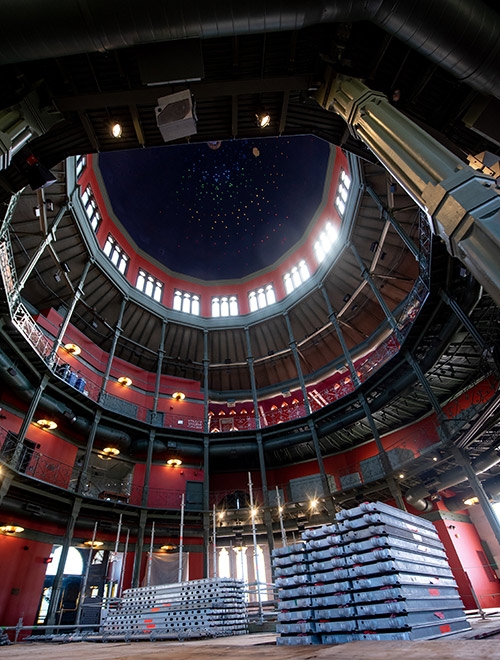The Nott Memorial reopened on May 19, 2022.
On a cold, blustery weekday, three contractors are inside the Nott Memorial, methodically assembling a lifeline for the centerpiece of Union’s historic campus.
The sound of steel hammered into steel echoes throughout the iconic landmark. The workers, who are with Duane Builders Inc. DBA Scaffold Builders Associates, are in the early stages of a three–week project to construct a giant erector set that will stretch to the building’s elaborate ceiling. It will take another three weeks to break down the massive ladder.
In between, workers laboring both inside and outside the domed edifice plan to administer emergency first aid to the 16-sided architectural treasure. The goal is to repair a nagging culprit for many homeowners: a leaky roof.
So for about the next three months, Union’s marvelous feat of High Victorian Gothic is off limits to the campus and the public. It is the longest closure for the Nott since it went offline for nearly 18 months as it underwent an extensive multi-million dollar restoration completed in time for the College’s bicentennial in 1995.
“It’s unfortunate we have to do this now, but we have no choice,” said Marc Donovan ‘05, assistant director of Facilities. “The campus depends on the Nott for many things, especially during finals week when it’s a popular study space. However, the risk is too high to ignore. This is the right decision.”
At 89 feet in diameter and 130 feet high, the Nott is a tribute to Eliphalet Nott, Union’s president for 62 years, the longest tenure of any American college president.
Opened in 1877, the Nott has hosted a museum, a library, a bookstore and a theater. Considered by many the soul of the College, the space has been used for lectures, conferences, readings, special events, and exhibits in the Mandeville Gallery and Wikoff Student Gallery. During the pandemic, the Nott was pressed into service as a classroom for the first time.
Added to the National Register of Historic Places in 1972 and the National Historic Landmarks in 1986, the Nott has been featured in a calendar, coloring book, and numerous books and publications.
Many first-time visitors marvel at its beauty.
“It may be all show, but what a show, what a feast for the eye,” noted historian David McCullough said at the rededication ceremony in 1995.
As he approached the podium for a talk in February 2006, Chuck D, a founding member of legendary rap group Public Enemy, glanced up at the majestic ceiling and then scanned the crowd, which filled the Nott.
“Wow. This is some (vulgarity) building,” he said.
However, like many aging structures, the Nott suffers the occasional leak. Recently, a chunk of plaster fell from the ceiling to the building’s floor. No visitors were inside at the time.
Thermal imaging of the ceiling confirmed the water intrusion, prompting the decision to close the Nott for repairs.
“If one piece fell, what’s to say another won’t,” said Donovan. “It is imperative that we correct the problem.”
Fixing the roof of a unique space like the Nott poses some challenges.
Inside, scaffolding will extend to 75 feet above the ground. A plywood deck likened to a wooden dance floor supports two rolling towers to allow contractors access to the ornate ceiling, sprinkled with 709 small colored glass windows, or illuminators. There, they will delicately replace 350 to 450 square feet of acoustic plaster 107 above the ground.
A series of plywood panels below protects the medieval multi-colored encaustic tile that make up the Nott’s distinctive floor.
Outside, contractors will use a 150-foot lift to inspect the dome perched atop the slate roof to pinpoint the source of the leak and make the necessary repairs.
Donovan said the goal is to have the repairs completed in time for Commencement in June.
As contractors climb more than 100 feet to reach the roof, perhaps they will find inspiration from a band of red slates girding the lower portion of the dome, which contains a modified Hebrew inscription from the Talmud.
Loosely translated, it reads:
“The day is short, the work is great, the Master presses the workmen.”


